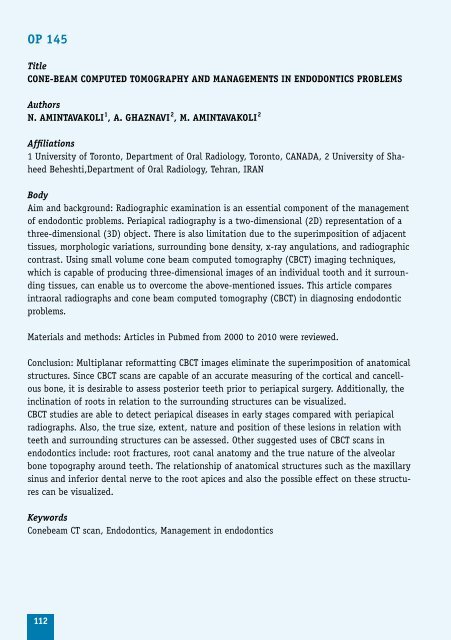Program including abstracts as pdf available here
Program including abstracts as pdf available here
Program including abstracts as pdf available here
You also want an ePaper? Increase the reach of your titles
YUMPU automatically turns print PDFs into web optimized ePapers that Google loves.
OP 145<br />
Title<br />
CONE-bEAM COMPuTED TOMOGRAPHy AND MANAGEMENTS IN ENDODONTICS PRObLEMS<br />
Authors<br />
N. AMINTAVAKOLI 1 , A. GHAzNAVI 2 , M. AMINTAVAKOLI 2<br />
Affiliations<br />
1 University of Toronto, Department of Oral Radiology, Toronto, CANADA, 2 University of Shaheed<br />
Beheshti,Department of Oral Radiology, Tehran, IRAN<br />
Body<br />
Aim and background: Radiographic examination is an essential component of the management<br />
of endodontic problems. Periapical radiography is a two-dimensional (2D) representation of a<br />
three-dimensional (3D) object. T<strong>here</strong> is also limitation due to the superimposition of adjacent<br />
tissues, morphologic variations, surrounding bone density, x-ray angulations, and radiographic<br />
contr<strong>as</strong>t. Using small volume cone beam computed tomography (CBCT) imaging techniques,<br />
which is capable of producing three-dimensional images of an individual tooth and it surrounding<br />
tissues, can enable us to overcome the above-mentioned issues. This article compares<br />
intraoral radiographs and cone beam computed tomography (CBCT) in diagnosing endodontic<br />
problems.<br />
Materials and methods: Articles in Pubmed from 2000 to 2010 were reviewed.<br />
Conclusion: Multiplanar reformatting CBCT images eliminate the superimposition of anatomical<br />
structures. Since CBCT scans are capable of an accurate me<strong>as</strong>uring of the cortical and cancellous<br />
bone, it is desirable to <strong>as</strong>sess posterior teeth prior to periapical surgery. Additionally, the<br />
inclination of roots in relation to the surrounding structures can be visualized.<br />
CBCT studies are able to detect periapical dise<strong>as</strong>es in early stages compared with periapical<br />
radiographs. Also, the true size, extent, nature and position of these lesions in relation with<br />
teeth and surrounding structures can be <strong>as</strong>sessed. Other suggested uses of CBCT scans in<br />
endodontics include: root fractures, root canal anatomy and the true nature of the alveolar<br />
bone topography around teeth. The relationship of anatomical structures such <strong>as</strong> the maxillary<br />
sinus and inferior dental nerve to the root apices and also the possible effect on these structures<br />
can be visualized.<br />
Keywords<br />
Conebeam CT scan, Endodontics, Management in endodontics<br />
112


